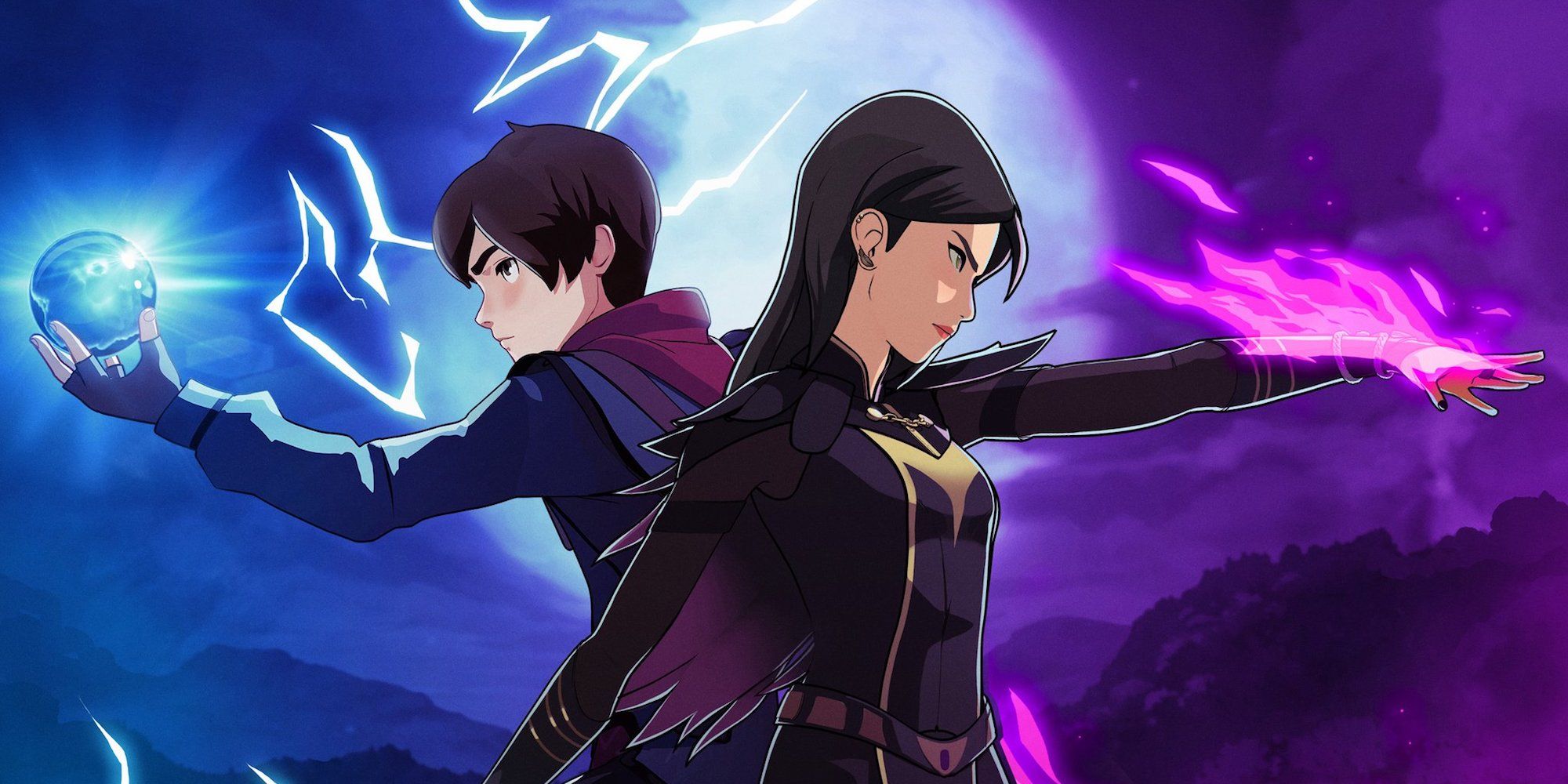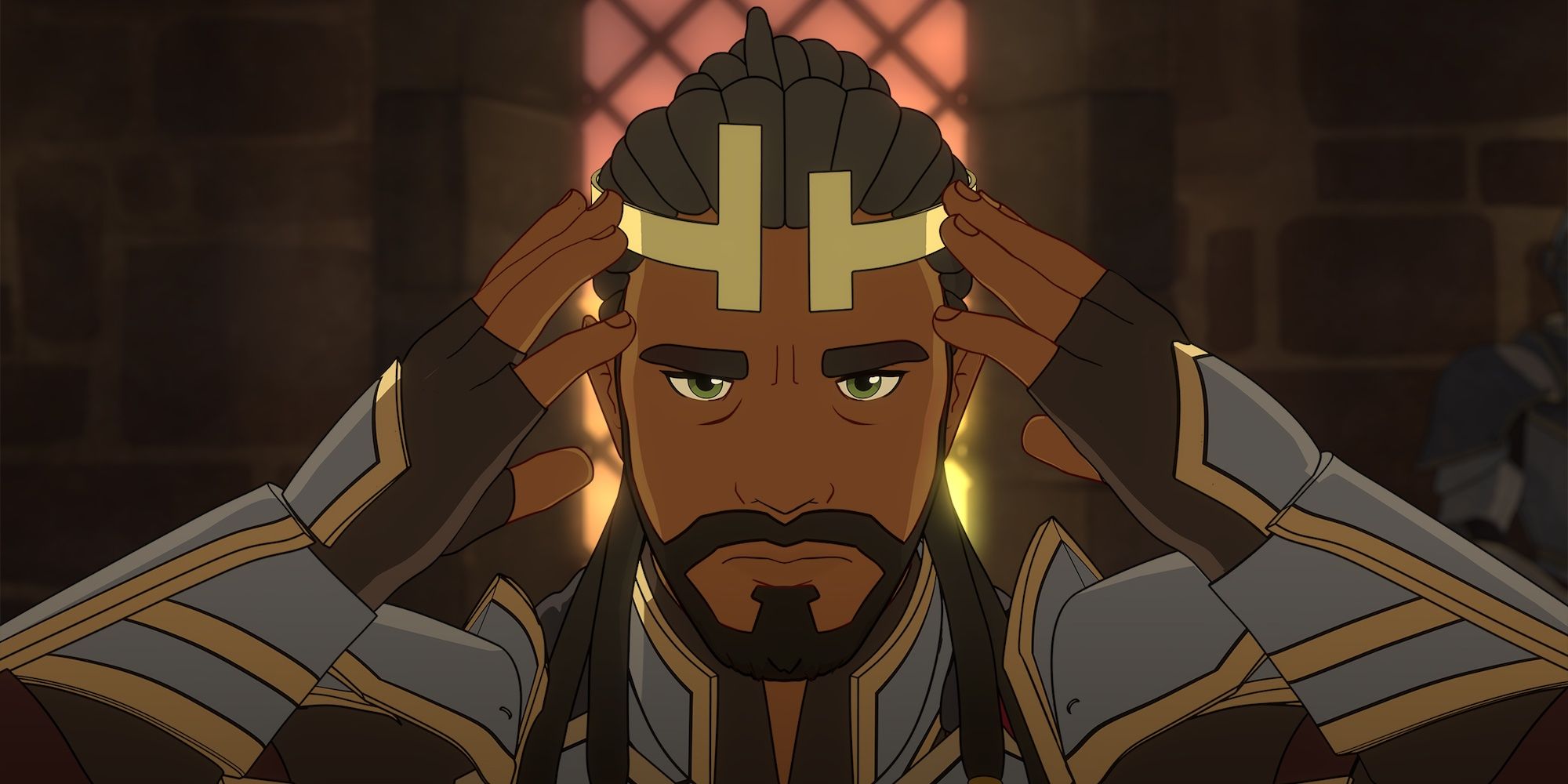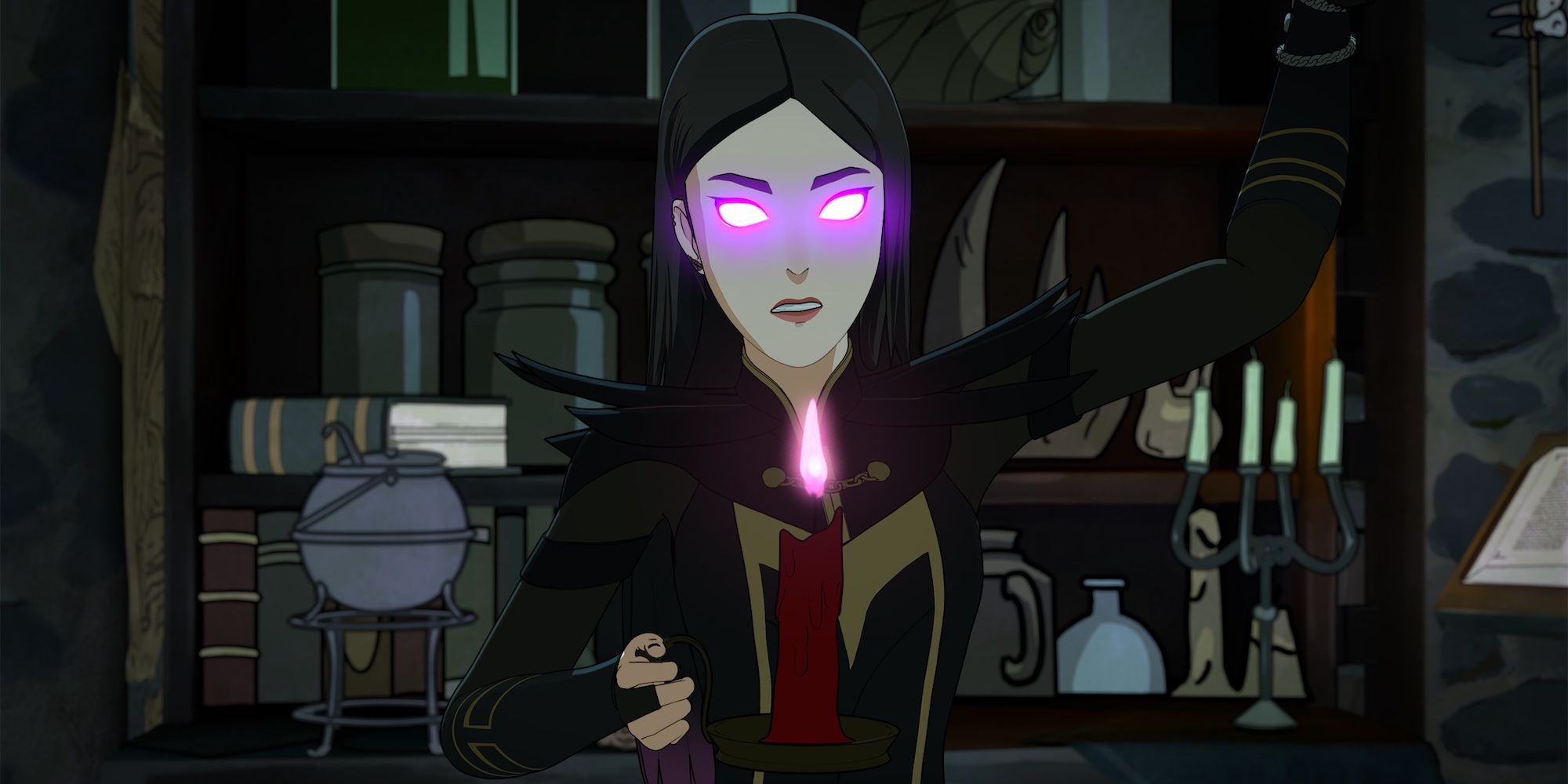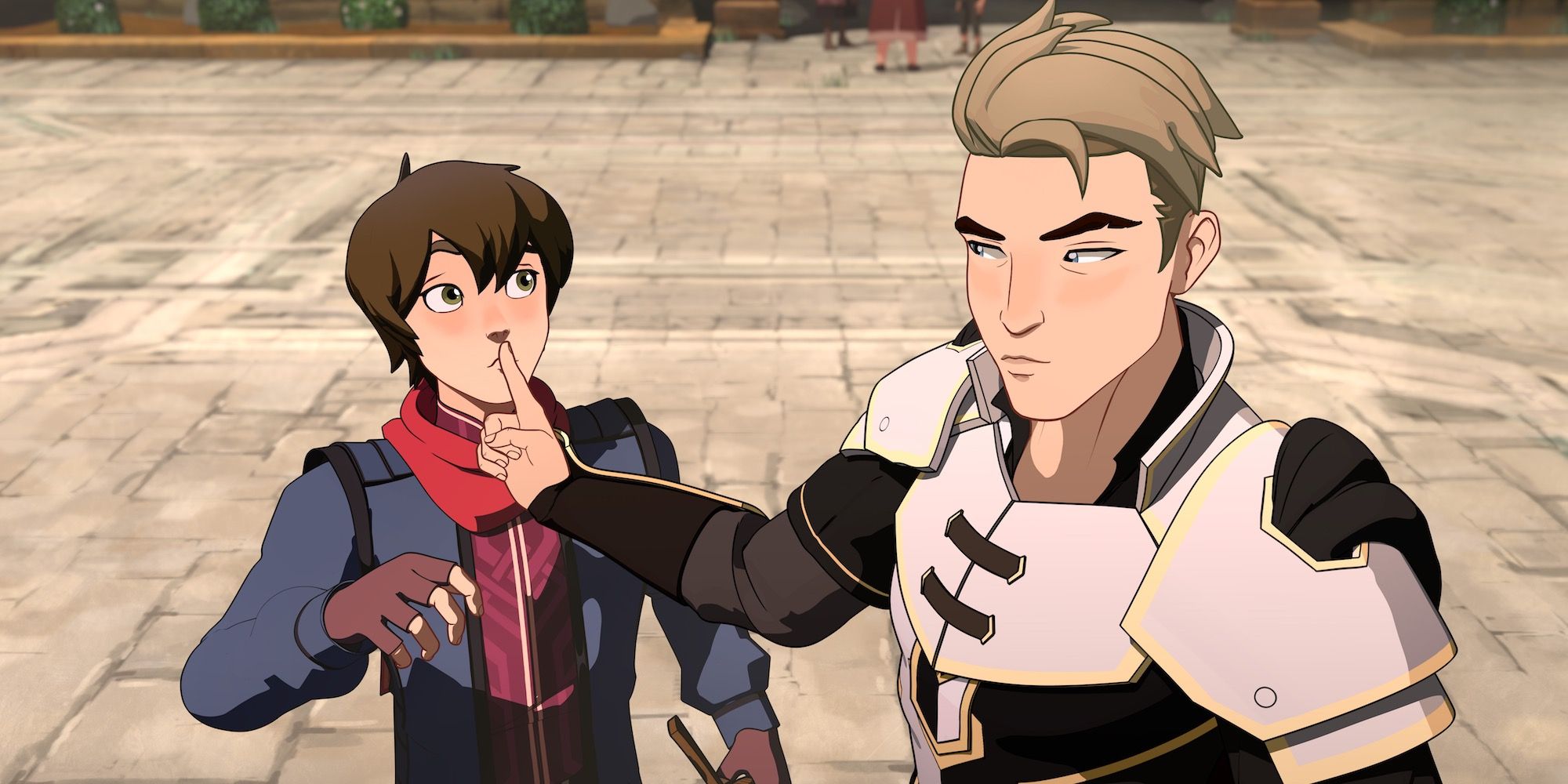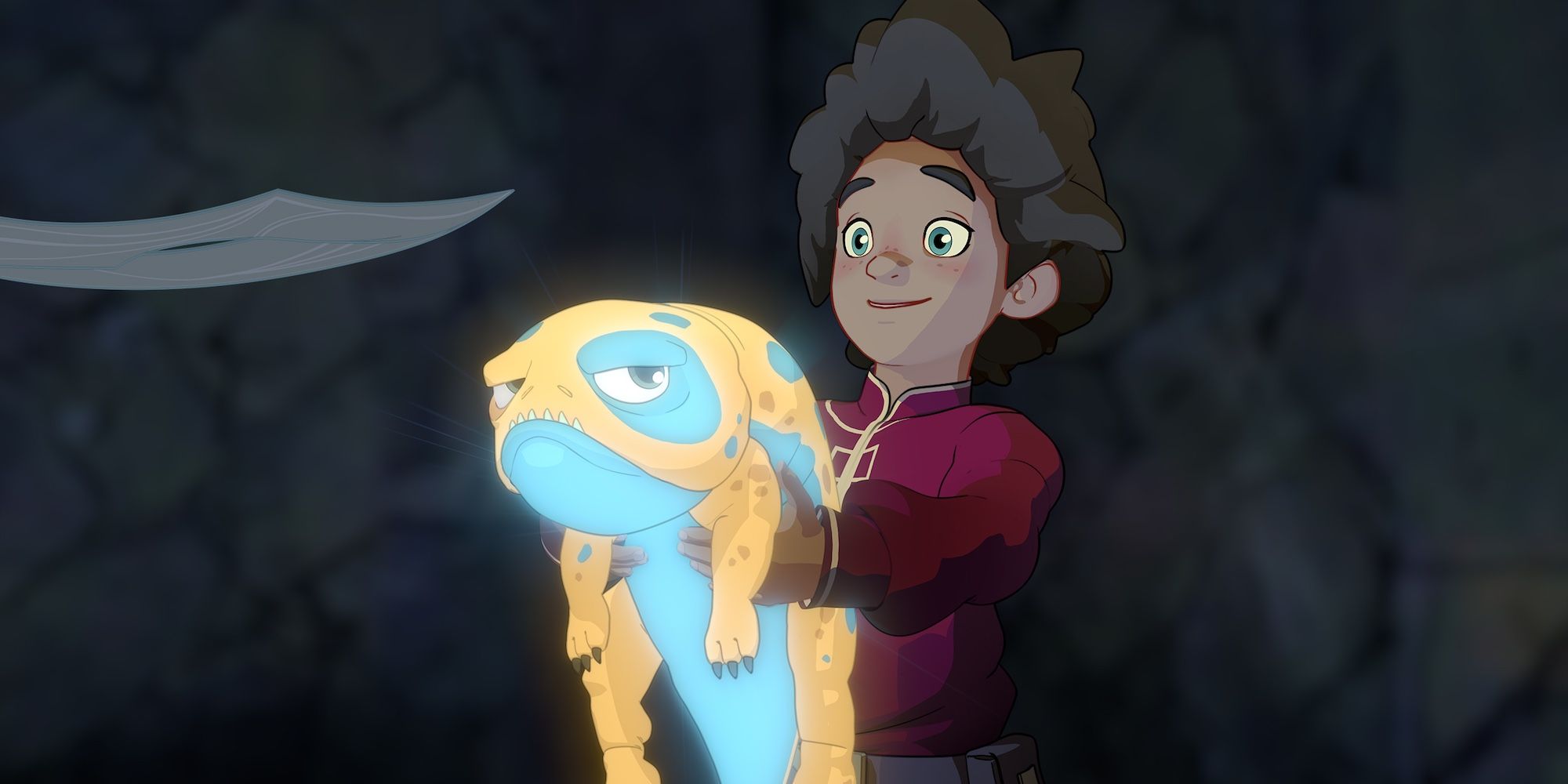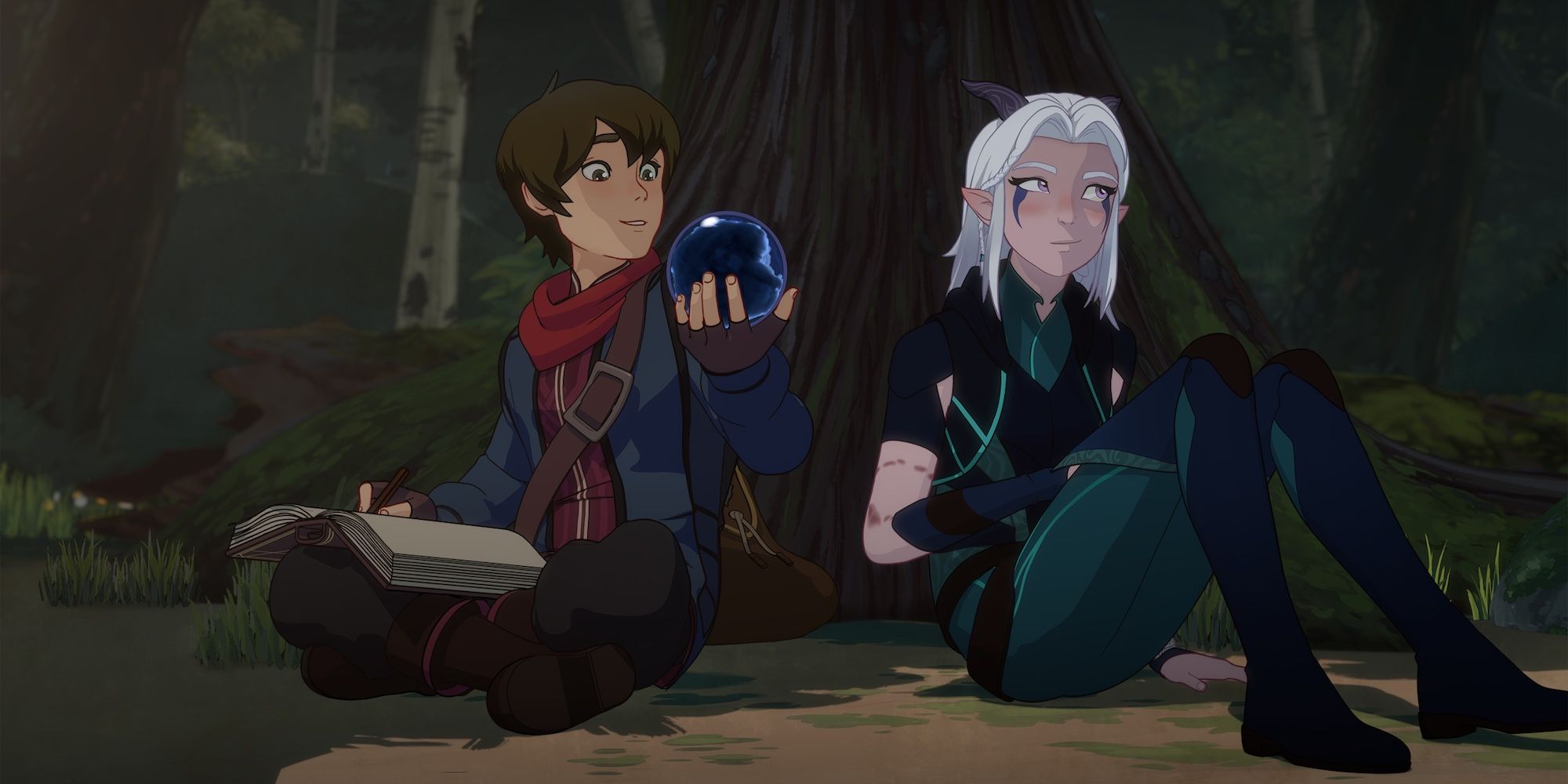Warning: SPOILERS for The Dragon Prince season 1 ahead.
The creators of Netflix animated TV show The Dragon Prince - Aaron Ehasz, Justin Richmond and Giancarlo Volpe - spoke to Screen Rant at New York Comic Con 2018 about the series' inspirations, why it appeals to children and adults and what its future holds.
The Dragon Prince season 1 premiered on Netflix in September, and it was met by an enthusiastic response from viewers (though, like all Netflix original movies and TV shows, specific ratings and viewership numbers have not been released). The first season, consisting of nine episodes, follows young princes Callum (Jack De Sena) and Ezran (Sasha Rojen) - and Ezran's pet glow toad Bait - who join forces with moonshadow elf assassin Rayla (Paula Burrows) in an attempt to end the war between humans and elves. But, they'll need to navigate a dangerous world of magic and misconceptions in order to bring peace to Xadia.
Related: Where Is Netflix The Best Value?
The co-creators of The Dragon Prince, writers Aaron Ehasz and Justin Richmond, and series director Giancarlo Volpe appeared at Anime Fest @ NYCC x Anime Expo last weekend, where Screen Rant had a chance to sit down with the team. Ehasz, Richmond and Volpe spoke about their inspirations for the series and its expansive world, how they balance the dark elements with optimism and the fact that The Dragon Prince was renewed for season 2.
Screen Rant: First off, can you walk me through the inspirations for this project, and the inspirations for this world?
Justin Richmond: So, a couple different sort of broad spectrum things we thought about was, we wanted to do a world that had... We started talking early on about what would it be like to be in a conflict where kids or young people are starting to see that maybe their parents, on both sides, made decisions that maybe they hadn’t made and the idea [that] can you change things? Can young people actually make a difference and change things? So we started with that really broad idea and then started looking at what kind of cool characters could fit into that scenario, and then Aaron had started thinking about some magic stuff pretty early on that we were talking about that was super cool. So that was a bunch of stuff that we started talking about and then we love fantasy, we love Lord of the Rings and Game of Thrones. I’m a huge fantasy nut and so when he was like, ‘I think we should do a fantasy thing.’ I was like, ‘Yes, this is the greatest thing ever!’ And then when we brought in the writing team and Giancarlo, they started putting their own ideas in, and then we have a game team also, and they started throwing ideas around. So all that stuff congealed into what became The Dragon Prince.
Screen Rant: So you mentioned Game of Thrones and Lord of the Rings and I feel like you can really see those inspirations in season 1 especially, so were there any specific ideas that you borrowed from those series? Or were there any other series that specifically inspired you?
Aaron Ehasz: I don’t think there were any specific ideas, I mean, I think in general we knew we wanted to play in the same kind of field as Lord of the Rings and Game of Thrones, but that meant we’re interested in there being magic and dragons and elves and different kinds of creatures. And we knew the stories would have characters who maybe didn’t start off as heroes but figured out that they could have a huge impact on the world if they only did the things they were brave enough to do. So I think we were probably more generally, area inspired than specifically inspired.
Screen Rant: How much of the world did you build before starting the story and how much of the story was informed by the world?
Ehasz: For us, I think there’s a lot of back and forth. So for example, I think the very first piece of The Dragon Prince story and the Xadia world that happened was some thoughts about a world where there was magic and dark magic, and what is the meaning of this dark magic that is quicker, dirtier, effective but also is consuming something that maybe wasn’t meant to be consumed by the mage. So that idea started, but then the first thing we did was imagine a scene of a mage passing on this knowledge to their child. And that mage and child, as that seed evolved, became Viren talking to Soren and Claudia when they were children. So those characters were born like immediately after the magic system was born because they helped us prove out and test the idea, whether it was interesting content, but also emotional content and so we kind of go back and forth.
Richmond: There’s another scene I remember that we did very early on that it’s backstory that’s not in the show but it was similar to that where it was like a very specific idea about how a piece of magic worked and that sort of informed some of the stuff as well.
Ehasz: Oh yeah, like I think the second scene we wrote was Claudia and Soren as adults and something happening that actually, in our minds, is what set in motion everything. It’s how Viren and Harrow were able to go to Xadia and kill the Dragon King and lead to all of this. So you just kind of follow these ideas, and not all of them make it into the story - ever - some of them are just background or inspiration or something that is triggering the next idea, but you work on it as if it could be. But some of them will make it into the story, now that we have a little more time to tell.
Richmond: Yeah, some of them will. Exactly.
Screen Rant: That’s what I love about season 1 is that you can tell as a viewer that there’s so much you guys have planned out, like the entire backstories of all of the characters, so, how much of that did you plan out beforehand, how much got cut, and how much do you think is going to come back?
Ehasz: It’s a combination. I would say that we come up with probably as much story that doesn’t get on the show, but is in our headcanon as gets on the show - maybe even more. I know that, like for example, we’ve talked about some backstory that me and Justin worked on just to kind of understand what happened with Thunder and what happened with Thunder getting killed, which we immediately shared with Giancarlo and talked about, and Giancarlo was like, “There’s gotta be a way for that to actually be a story!”
Giancarlo Volpe: Yeah, that was a really early thing.
Ehasz: So that’s something that we’re hoping in the future, we’ll be able to share that story directly and not just have it inform the story.
Richmond: That was one of the first things we talked about with you, wasn’t it?
Volpe: I feel like, yeah, I remember it was super early. What I wanted to say, too, in terms of world building versus story - I think this is a good example - is Claudia’s hand light spell. So in case people aren’t fully aware of the rules of it, it’s basically if you do primal magic - which is the sun, moon, stars, etc. - you draw a rune, and then cast the magic. And in dark magic, you take a [magical item] and you consume it and then that casts the spell. … And there’s a scene in the second episode where Claudia turns on this hand light so she can investigate down the secret tunnel and this is maybe my fault but she draws a rune, in the original storyboard she draws a rune and then casts this light spell and we realized, “Oh this doesn’t make sense with our magic rules,” so we had to go back and change it. So that happens a lot in the writing room and as well as in the boards, where it’s like you kind of work out the story and then have to go back and make sure that all of the rules are consistent. It’s a little bit of a back-and-forth kind of thing.
Richmond: I feel like we oftentimes... Giancarlo will come back with a board that’s like, before we had a bunch of these things absolutely ironed out, it was like some really cool thing and it was like, “Well, how can we make that work inside of the existing rules or should we change the rules a little bit to allow this.”
Ehasz: Part of what’s great about Wonderstorm, which is the company we started to do The Dragon Prince and also to do the video game that we’re doing, is that our team is full of— in addition to writers and artists, we have game designers and engineers, who sit in on these brainstorming meetings, and beat us up over system problems and over inconsistencies. So they kind of almost enforce a more rigorous kind of world-building. Not just enforce it, but also contribute wonderful ideas to the world-building. But it’s a cool situation because a lot of the world-building is constantly being tested by our team and pushed and stretched and that helps us make something that has a magical physics to it that feels right.
Richmond: So Giancarlo, when he did the boards - he did the boards for the first three himself and then we had our partner Bardel, that had directors and board artists up there, and they know the rules as well as we do now. So they’ll do like, “Well I don’t know guys…” Like, they’ll have that same rigorous thing, so we’ll have another check-and-balance on top of our company, which is really cool too.
Screen Rant: Essentially, The Dragon Prince is for children since it’s an animated show, and there’s some ambiguity there with King Harrow’s death especially - I’m a huge fan of Avatar: The Last Airbender and there was major ambiguity with a character death in that show, notoriously, so can you talk a little bit about balancing those darker aspects of death with lighter aspects since this is aimed towards children.
Ehasz: So first of all, I’m going to ask you - I’m not going to ask you how old you are, but you’re an adult person sitting here and you said, “I am a fan of Avatar: The Last Airbender” - was it aimed at children?
Screen Rant: Yes?
Ehasz: Yes? With a question mark?
Screen Rant: I mean, I was 15 when I started watching it.
Ehasz: Right, right, exactly, so that part I’m not even 100 percent sure is a fair assumption that it’s aimed at children. Right? So, I think the truth is it’s made for both - it really is. And so was Avatar. It was like, we made it on Nickelodeon, and Nickelodeon was making programming for 6-11, but we were making something for ourselves, we were making something for intelligent kids, we were making something for parents, for people who loved imaginative storytelling. And I think that’s the same idea here. So if I could reframe the question, it’s almost like how do you do storytelling that you hope has the depth and dimension to appeal to, especially cool adults like us, but also is a good fantasy story that kids will find enticing and interesting. And to make it interesting for adults, you have to have real stakes like death and loss. Well, the truth is, what we believe is those are real to kids too. Like, seven-year-olds have lost their grandparents, they’ve lived in the world, they know that’s happening. They may not be intellectually ready to cope with it, but they see the emotions of those things happening. So what we do is we’re very careful in the actual storytelling, there’s nothing that’s going to violate the trust of a parent with a kid, that’s going to be like immediately violent or so, so horrifying in the moment. But we think that it’s OK to have real things - like death and loss - there. So you can know that it happened in a way that is a discussion and a feeling and not like a sensory thing that you don’t know how to cope with intellectually, that’s going to give you nightmares. So that’s an area that we see as an opportunity to do stronger storytelling for young people, is telling those big stories in a way that’s appropriate, but not sanitized.
Volpe: Can I go on a screen rant? [Laughs] On that topic, people my age often cite Star Wars as such a huge inspiration and in the very first Star Wars, we saw Luke Skywalker’s aunt and uncle get incinerated.
Richmond: Spoiler!
Volpe: His mentor gets cut down…
Richmond: An arm gets cut off.
Volpe: Well, yeah, in the later movie.
Richmond: No, in that one, in the bar.
Volpe: Oh yeah, I forgot about that. All of these horrific things, and I saw that movie when I was 4 or 5 years old and you kind of get it and it’s fine and it’s fun because the Jawas were cute and you’re inspired by Luke Skywalker and by Princess Leia. And what’s common in animation for whatever reason - this is my screen rant - is we’ll get notes from Standards and Practices or sometimes networks that are like, “Oh, when this soldier gets killed, can you cut to them on the ground like sort of moaning, just so we know that they’re not dead, they’re just hurt.” And it’s like, but I saw Stormtroopers get shot to death repeatedly as a kid and it never gave me nightmares, I’ve never shot a Stormtrooper myself. [Laughs] I think kids are way smarter than most people think, so I love that in Dragon Prince we’re not afraid to include those parts in a story if the story calls for it. And I don’t feel like it’s ever gratuitous or too far, it’s just enough to make the story real.
Ehasz: And it’s not just Star Wars, like the great Disney movies have always done it. I mean, Bambi’s mother dies, and it’s not gentle, it goes down in a horrible moment. So those darker moments and those big moments have been a part of children’s storytelling for a long, long time. Something happened in the last couple decades, I don’t know if it was the ‘90s or when, where someone went, to make this for kids, you dumb it down and you sanitize it. And that became the trend. So now all of a sudden, oh it’s so surprising— but no, this isn’t new, this is Star Wars, this is Disney. You can tell appropriate stories for kids if you approach it with empathy for your audience, you understand who they are and have a sense of touch around that storytelling, you can approach those topics, you don’t need to sanitize it.
Screen Rant: So in terms of The Dragon Prince, I’ve noticed that I and a lot of people my age - like, late 20s, early 30s - we watch animated shows like The Dragon Prince and Voltron and Steven Universe as sort of anxiety relief. … So how do you guys feel about that?
Ehasz: Can you tell me what relieves anxiety about watching that?
Screen Rant: I think it’s part nostalgia - like right now I’m rewatching Avatar: The Last Airbender and it’s just so comforting to live in this world for a little bit where good wins at the end of the day, and I know that good is going to win at the end of the day because that’s the story that animated shows [in my experience] tell.
Richmond: That’s awesome.
Ehasz: Yeah, I love that.
Richmond: Like, one of the reasons I wanted to make this show with these guys was because it’s hopeful, and I had worked on some fairly dark stuff before that that just like mentally was exhausting and it’s really nice to hear that you like it for that reason.
Volpe: Yeah it’s interesting that you say that because I think we all have been assigned dark-y, McDarkstein stories at some point and I think that it was a collective thing where we were like, let’s make— we want to do something that’s hopeful. That was a common thread for all of us.
Ehasz: My core belief about that, hopefully, is you have to not fake it being good and positive. Like people will watch a thing and everything turns out well, but it’s just because it does, then that doesn’t do anything for you. So hopefully what the shows do is present real obstacles, real dilemmas, real flaws, insecurities, the characters go through something that legitimately resonates as hard because it’s real and it’s authentic and then through some authentic process of character development, they overcome it, or begin to overcome it or get a glimpse that they can overcome it - something that feels possible and not something that feels fake. So it’s always really important, I think, at a core we have an optimistic, resilient feeling about characters who have good hearts and things like that. But I don’t know, you have to be real about the world to some degree to earn the ability to say, “But you can still be resilient and you can still be strong.” So that’s the balance that we try to find. So thank you for saying it relieves anxiety.
Volpe: I love that moment too - not just in stuff we worked on but stuff that I watch and admire - when the hero feels stuck and then thinks of something very clever or resourceful. I love those kinds of stories. And it requires that you feel hopeless with them for a moment or for an episode or for an act, and it actually feels that much better when they figure out how to succeed.
Richmond: I think, ultimately, we’re all fairly hopeful people.
Ehasz: Not blind optimists, that’s the thing is like blind optimism is not— I think there’s something about having a very realistic optimism that can be powerful. If you can actually look at the world, which is full of bad things and disappointments and frustrations and bad actors who are doing bad things and still realize there are good people out there, there are people who want to make a difference, there are people who want to do things a different way, and I can find them and I can connect with them, I can make a difference despite all the nuttiness, then that’s something. That’s what we want.
Screen Rant: I’m curious, because I think all of you have worked on network animated shows…
Richmond: I have not, but these guys have.
Screen Rant: OK, a network show versus Netflix - because I always hear that Netflix gives creators a lot more freedom. So what was it like moving from a network to Netflix?
Volpe: What is noticeable is, y’know, we all have gotten that document of notes that’s a response to a script or an animatic or whatever from the network and the only time we get one from Netflix, it’s like three bullet points or something. And they’re often sort of like, “It might be nice to do this, but you guys are good.”
Ehasz: Emphasis on, the creative executives who support us are selective about the notes they give - they don’t just give a pile of them - and they come at it from a very supportive angle, not a control angle.
Volpe: I think that that’s very true.
Ehasz: It’s not just that they’re not in the way, it’s that the creative executives are supportive.
Volpe: And I think that’s important, too, because it’s always welcome to get a very good note that’s like, “Oh my god, that makes the episode so much stronger.” But there is definitely a point where it starts to feel like meddling or you’re now losing time because you’re redoing things that are probably fine and that doesn’t feel like the case with Netflix so I’m very thankful for that.
Richmond: Creatively, they’ve been exceptionally supportive of what we’re trying to do and never felt like they were in the way.
Ehasz: From a launch perspective, they have a way of doing things that’s new and we’re adjusting to that and trusting them.
Screen Rant: You guys have a season 2, congratulations! Have you started working on it, thinking about it, do you guys know where you’re going - what can you tease?
Ehasz: You can ask me about season 7, have we started working on it, and I would say, “Yes! I had some ideas for it in the shower three days ago.” But yeah, no we’ve already started working a lot on— we’ve made a lot of progress. We know the story we want to tell, and it’s ready to be brought to life.
Richmond: I mean we knew, even from season 1, we sort of knew where the story was headed very early on. So it was really nice that we got the pickup and that we’re able to go tell more of it. As long as people keep watching this thing, hopefully we’ll get to tell the whole story we want to tell.
Screen Rant: So you have an endgame in mind?
Ehasz: Yes.
Richmond: Yes, for sure. This is not— we’re not going blind, going like, “Well, let’s figure it out as we go.” I mean, there is some of that. But in terms of core story ideas, we know exactly where it’s headed.
Volpe: And also, it’s not like the intention is that this show will go on indefinitely, either. Like there’s sort of a “The End” that you have in mind, would you say that?
Ehasz: Yeah, I mean there’s always going to be some balance [of] what’s the story we have the opportunity to tell, and what’s the big vision that we’d like to tell. But yeah, the big vision version, we do have a very specific ending that we would love to build towards if we have the opportunity.
Richmond: I mean the world’s big enough that we could explore it forever, ideally, but there is an end to this story.
Volpe: To use Avatar as an example, like, the point of it was that Aang must learn the four elements so that he can confront the Fire Lord and defeat the Fire Lord. It wasn’t just Aang will play with elements forever until that gets old - like there was always that [end goal] and I think that there’s talk of that on Dragon Prince, too.
This interview has been edited for length and clarity.
Next: Every Trailer Released At New York Comic Con 2018
The Dragon Prince season 1 is available now on Netflix.

